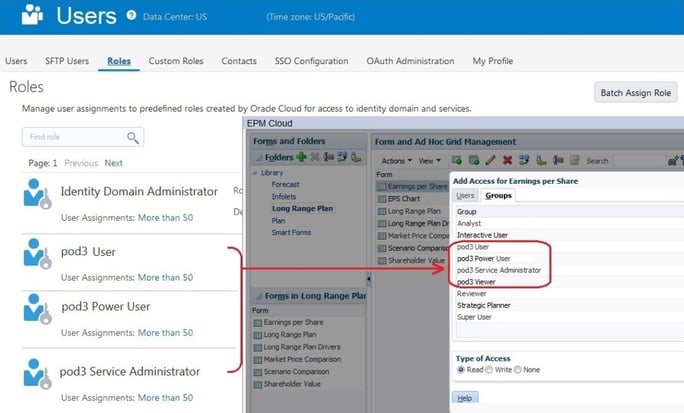The November updates for Oracle's Account Reconciliation Cloud Service (ARCS) have arrived. In this blog post, we’ll outline new features in ARCS, including export of adjustments and transactions as journal entries and REST APIs for Managing Users.
We’ll let you know any time there are updates to ARCS or any other Oracle EPM cloud products. Check the US-Analytics Oracle EPM & BI Blog every month.
The monthly update for Oracle ARCS will occur on Friday, November 16 during your normal daily maintenance window.
ARCS New Features
Export of Adjustments and Transactions as Journal Entries
In Transaction Matching, you can export adjustments or transactions as dual sided journal entries that can then be imported into your ERP system. Using Jobs History, the exported journal entries are made available in a text file.
In addition, attributes for Adjustment and Support Types have now been made global so that you can reuse these attributes by choosing from a drop down list.
The process for exporting adjustments and transactions as journal entries is:
- Create global attributes for Adjustment and Support Types.
- Define the journal columns.
- Map transaction/adjustment attributes to journal attributes.
- Optionally, when exporting transactions, you can filter the list of transactions.
- Perform the export of the journal entries in a text file using Jobs History
Variance Analysis Monthly Format Added
A Variance Analysis Monthly standard format has been added to the 19 other pre-delivered formats that are provided by ARCS.
Create Match Process Without an Auto Match Rule
You can now create a match process without an Auto Match rule present. This enables customers who want to perform manual matching only in Transaction Matching to create a match process without any auto matching rule.
Proposed Changes to Application-level Access Control
Using Groups created in Access Control, EPM Cloud supports application-level access control for planning, consolidation and close, tax reporting, and Oracle Enterprise Data Management Cloud applications. In addition to the custom groups created in Access Control, access control screens list predefined identity domain roles (Service Administrator, Power User, User and Viewer) as groups.

With a view to simplifying security across EPM Cloud and to ensure that application-level access control can be seamlessly migrated across environments Oracle plans to remove the ability to display predefined roles as groups in access control screens. After this change, you will no longer see predefined roles listed when you search for groups in access control screens.
Note: The proposed change will not affect how you create and manage groups or use them for applicationlevel access control.
Before making this change, Oracle wants to evaluate the impact, if any, that the proposed change will have on your environments. If you are concerned that the proposed change will affect your environment, please create a service request explaining your use case.
New EPM Automate Utility Version
A new version of the EPM Automate Utility is available with this update. This version includes the following new commands:
- addUsersToGroup, which adds a batch of users to an existing group in Access Control using an ANSI or UTF-8 encoded Comma Separated Value (CSV) file that was uploaded to the environment.
- removeUsersFromGroup, which removes users listed in an ANSI or UTF-8 encoded CSV file from a group maintained in Access Control.
Additionally, this version includes enhancements to the following commands:
- assignrole: this command has been enhanced to provision users with roles belonging to a planning, consolidation, tax reporting, or data management application.
- unassignrole: this command has been enhanced to revoke the application roles granted to a list of users identified in a CSV file.
- provisionreport: this command has been enhanced to, optionally, generate a Provisioning Report (.CSV format) that lists only the users who are assigned the Identity Domain Administrator role. This command has also been enhanced to, optionally, create a simplified version of the Provisioning Report, which lists only the pre-defined roles and inherited application roles to which users are assigned. By default, this command now generates the classic Provisioning Report, which lists component roles that are subsumed into the pre-defined roles.
Note: In a future update, Oracle will make the simplified Provisioning Report as the default report that is generated from Access Control as well as using the provisionreport command. You will still be able to create the classic Provisioning Report using this command.
REST APIs for Managing Users
You can now use REST APIs to perform these user management-related operations:
- Add users to a group
- Remove users from a group
- Add users to an identity domain
- Assign users to predefined roles
- Remove users' role assignment
- Remove users from an identity domain
- Add users to a group Remove users from a group
Improved Performance while Uploading and Downloading Files
This update features improved performance while processing large files using the following EPM Automate commands:
- copyfilefrominstance
- downloadfile
- uploadfile
Considerations
Academy
In the Academy, some pages and icons may appear different in the video and the Cloud service.
Using Refresh
It is a best practice to use Refresh within the Account Reconciliation Cloud user interface rather than performing a browser refresh.






